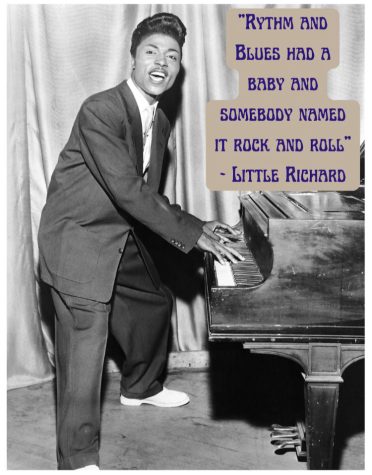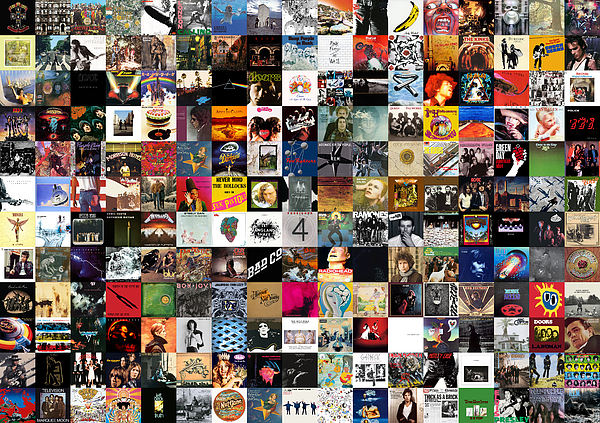Dive into rock ‘n’ roll
August 24, 2022
Rock ‘n’ roll is the heart of America that’s constantly developing new styles and has been turning out the greatest songs since the late 1940s. Though everyone knows and loves it, they often fail to realize just how it became the rock ‘n’ roll we know today.
Rise of rock
Rock had its first baby steps in the late 1940s, even though it wasn’t always known as rock. Styles such as soul music, and rhythm and blues (R&B) were beloved genres that originated in, and were heard throughout African American communities. Both of which are to thank for popularizing and influencing the creation of rock ‘n’ roll.

When the 1950s rolled around, rock started to emerge, releasing countless hits. In the mid ‘50s, songs relied on the electric guitar’s energizing feel, immediately launching rock to the top charts. The very first rock ‘n’ roll hit that charted at number one was “Rock Around the Clock” by Bill Haley. At this point, rock started to dominate the charts with artists including Elvis Presley, Chuck Berry, Little Richard and Buddy Holly. However, it started to cause considerable turmoil among the different generations. The younger generations gravitated toward its fun and rebellious vibe, but the older generation did not feel the same. Considering they labeled it as “Satan’s music”, they did not appreciate its youthful freedom during such a conservative time. Thousands of parents wished rock ‘n’ roll would disappear after the ‘50s, hoping their kids’ love for it was just a phase, but boy were they wrong.
It wasn’t until about 1963 that rock began branching out into the diversity that we experience with music today. It was also up until this point that rock ‘n’ roll was just an American phenomenon. People around the world fell in love with rock and artists yearned to create songs just like it, especially those from the United Kingdom. On February 7th, 1964, the Beatles arrived in the United States kickstarting the “British Invasion”. Later Followed the Rolling Stones, the Kinks, the Who, the Yardbirds and more. A few of the most well-known subgenres of the ‘60s include surf rock, psychedelic rock, and hard rock. Surf rock didn’t sound very different from the music of the ‘50s, but people still loved playing the Beach Boys for a nice day in the sun. Psychedelic rock was more popular during the late ‘60s and was associated with hippie counterculture and drug use. Artists and bands like Pink Floyd, Jimi Hendrix, the Grateful Dead, Janis Joplin, the Zombies, Jefferson Airplane and the Doors typically used interesting lyrics with unusual instruments to heighten the experience caused by mind-altering drugs. Hard rock took the elements of rock ‘n’ roll and made them more aggressive. Their raspy voices, rebellious lyrics, hard-partying lifestyles and edgy clothing, along with the garage rock sounds, were displayed by many famous bands like Deep Purple, the Who, Black Sabbath and Led Zeppelin. The 1960s wasn’t just a memorable time for music but also for history, both of which had started to merge. Motown and popular R&B music held significant roles during the civil rights movement. The success of African American groups, singers, songwriters, and management proved to break down the barriers of segregation, as some even used their talents to create songs on the fight for justice. In the late ‘60s, many rock songs had started to reflect the matters in America as well as the protests that were created because of those matters. Bands released songs that tugged the heartstrings of their listeners and urged many to fight for what was right. As the 1960s came to an end they made sure to cap off the decade in the most fitting way; Woodstock. Woodstock was one of the greatest known music festivals, and it was held on August 15-18 of 1969. Bands performed all night long, and music lovers listened to each and every song especially those performed by Creedence Clearwater Revival, the Who, Jimi Hendrix, Santana and Janis Joplin.

When looking at the 1970s it is clear that rock had expanded tremendously over the past few decades. The new subgenres, along with the variety of bands, allowed for an influx of rock ‘n’ roll fans. Some rock bands that emerged in the ‘60s had grown a lot more prominent as the ‘70s went on, however, others broke apart or lost important members. The Beatles were no longer the Beatles, and the deaths of Jim Morrison, Jimmi Hendrix and Jannis Joplin bruised fans across the world. During the late 1970s, rock went through a whole movement of punk rock, bringing back the raspy voices and garage band sounds heard partially in the ‘60s hard rock. Punk bands including the Ramones, the Clash, and the Sex Pistols rose to fame during this time, adapting their own style and subculture. Rock had become heavier and louder thanks to bands like Led Zeppelin and Black Sabbath. Many songs began to mix in old styles of rock like soul music and the blues. The ’70s had also welcomed new artists like David Bowie, the Eagles, and Queen. All of whom would quickly grab the attention of people worldwide.
The 1980s was the decade of big hair, bright colors, and new wave. Mainstream rock had gone stale, but subgenres like punk, heavy metal, alternative, glam rock and more dominated the charts. New Wave was by far the most popular with bands including Duran Duran, the Police, the Cure, Tears for Fears and the B-52s. Admired songs at the time blasted from boomboxes, aired on the MTV channel, and played through the headphones of every fans’ Walkman. Numerous subgenres ruled the 80s and on July 13, 1985, they were all able to come together to be heard at Live Aid. Live Aid was a huge benefit concert broadcasted on TV, and performed live at a large arena in London. An estimated 1.5 billion viewers tuned in and raised more than $140 million for famine relief in Africa. Numerous well-known rock stars and bands performed including Queen, Duran Duran, U2, David Bowie, the Who, Paul McCartney, Elton John, Sting, Mick Jagger, Bob Dylan and more. Rock was being used for the good of the world.
The early 1990s were controlled by alternative rock and grunge. The fun music of the 80s was still loved, but not nearly as popular as it had been years before. Nirvana, the Red Hot Chili Peppers, Alice in Chains, Pearl jam, the Smashing Pumpkins, Radiohead, Aerosmith and Jane’s Addiction went on to experience massive success. However, the suicide of Kurt Kobain, Nirvana’s lead singer, in 1994 greatly impacted the fans of grunge and changed it forever. At this time it’s almost hard to pinpoint an exact style of rock. It changed so much from what we knew it as in the ‘50s and some subgenres had even become their own entire genre. Though rock had had become such a broad genre, that does not mean that it didn’t significantly impact the music world. Without rock many genres today would not exist, and when you come to think of it without the blues we would never be able to get to this point. Every talented artist wouldn’t be able to prove his or her skills nor jump in and out of different styles. Music festivals most likely wouldn’t be as memorable, fans wouldn’t be able to turn to their beloved music as support, and in all, the world would never get to experience the crazy life and work of a rockstar.
As for current rock, there isn’t really one dominating kind. Subgenres are popular, and so are the classic songs from decades ago. Personally, my dad has always been a rock fan and because of that, I have an interest in the genre like many other people. If you look through my playlists and surely thousands of other teens you won’t only find today’s top hits. Honestly, it’s a perfect mix between the music of today and the Beatles, the Ramones, Fleetwood Mac, Cream, the Doors, Nirvana, the Who, the Red Hot Chili Peppers, Jimi Hendrix, and plenty more. Rock not only shaped music in general but also my love and appreciation for it.
Dark side of rock
“Sex, drugs, and rock ‘n’ roll” is a term frequently used to describe the lifestyle of a rockstar. They are known for being possibly the coolest, craziest, and most rebellious people. But behind all the large crowds, extravagant clothing, loud performances and crazy parties, our loved legends are typically everyday people struggling with dark inner thoughts and addiction. For rockstars, it is especially hard to avoid drugs and alcohol when it consumes your life and the people around you. They are introduced to copious amounts of addictive substances regularly throughout their career, unfortunately leading to the deaths of many of our favorite stars. And though performing in the spotlight has helped many artists to embrace themselves and gain confidence, it has also hurt many by turning something so joyful into something too overwhelming in a matter of years. Many began to feel alone and stuck with their problems, turning to drugs in hopes to solve them. Oftentimes, addiction and mental health issues took the lives of influential and talented stars. Even young artists who had only been involved in the music industry for a few years got pulled into the dark side of rock ‘n’ roll. Quite a few were as young as 27, those of which had become members of the “27 Club”. The “27 Club” describes the multiple stars that passed away at the cursed age of 27, many including rock stars. Numerous theories circle this unofficial club, however, the most popular one covers the trade of life for quick success. Some believe that stars had “sold their soul to the devil for fame” resulting in death at the young age of 27. Though it’s interesting and a little eerie to think about, it is just a theory on some odd consequences and tragedies noticed throughout the history of rock ‘n’ roll. Jannis Joplin, Jim Morrison, Jimi Hendrix, Brian Jones, Kurt Kobain, and Amy Winehouse are all members of the infamous “27 Club”. Each artist impacted the music world immensely, and their deaths devastated fans all over the world. Whether they did “sell their soul” or not it still shows that rock isn’t always as glamorous as it seems and that the dark side can cast a shadow enveloping some of its most important members.
Rock ‘n’ roll’s lasting effects
The legacy of rock ‘n’ roll lives on. Many films and documentaries portray the lives of these stars, encapsulating both the good and dark times throughout their careers in the music industry. Each film shows the shining fame along with the inner struggles of numerous artists and bands involved in rock ‘n’ roll.

Deb McQuillan • Aug 28, 2022 at 12:22 pm
Outstanding read!
Mspe • Aug 24, 2022 at 7:19 pm
Great website!
Gail Lee • Aug 24, 2022 at 7:09 pm
Great article!!